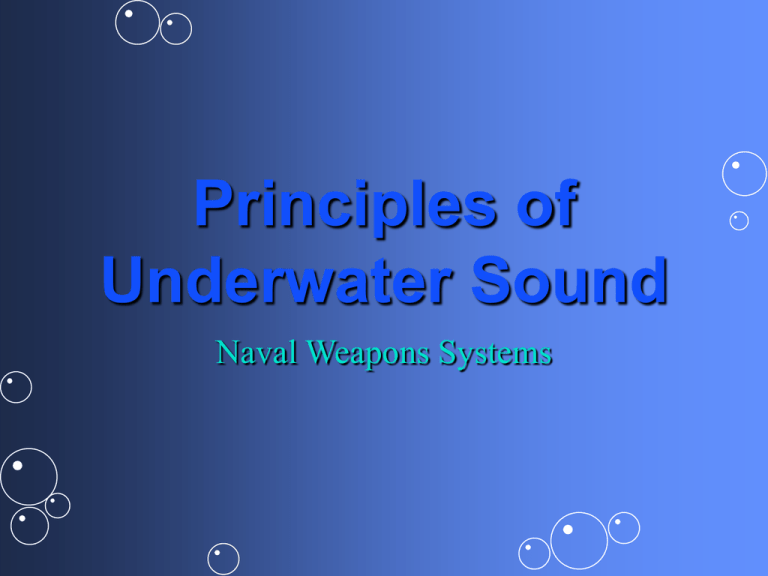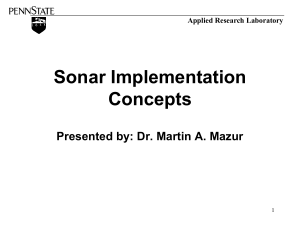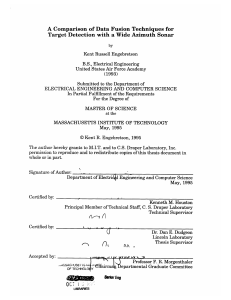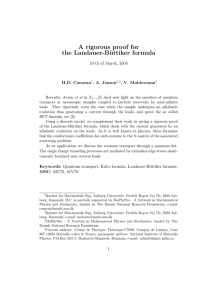Principles of Underwater Sound
advertisement

Principles of Underwater Sound Naval Weapons Systems Detection & Position Fixing •Active •Passive Why do we use SOUND? • Range of Penetration into the Medium. • Ability to differentiate between objects in the Medium. • Speed of Propagation. Concepts of Sound • Three (3) elements required for this to work – Source – Medium – Detector (Receiver) • The source VIBRATES causing a series of compressions and rarefactions in the medium • Most concepts already discussed will apply What a Concept ! The faintest 1000 Hz tone heard in air has pressure variations of only 2/10,000,000,000 of one atmosphere of pressure. The corresponding particle displacement is smaller than the diameter of an atom. Transmission Losses • Two main types: • Spreading – Spherical (omni-directional point source) – Cylindrical (horiz radiation only, or thermal layer, or large ranges compared to depth) Transmission Losses (cont.) • Attenuation – Absorption • Process of converting acoustic energy into heat. • Increases with higher frequency – Scattering and Reverberation • Volume: Marine life, bubbles, etc. • Surface: Ocean surface, wind speed • Bottom: – Not a problem in deep water. – Significant problem in shallow water; combined with refraction and absorption into bottom. Self Noise • Machinery Noise – Pumps, reduction gears, power plant, etc. • Flow Noise – High speed causes more noise – Hull fouling - Animal life on hull (not smooth) – Want LAMINAR flow • Cavitation – Low pressure area – Bubbles collapse, VERY NOISY Screw Cavitation Blade Tip Cavitation Sheet Cavitation Water Flow Water Flow Screw Speed , Pressure behind screw blades , Water Boils, Bubbles form, The subsequent collapsing of the bubbles cause the noise. Going deep increases pressure so can go faster without cavitating. Ambient Noise • Hydrodynamic – Caused by the movement of water. – Includes tides, current, storms, wind, rain, etc. • Seismic – Movement of the earth (earthquakes) • Biological – Produced by marine life • Ocean Traffic – At long ranges only low frequencies are present. How do we detect a submarine? • Detect the reflected SIGNAL • Detect the signal over the background NOISE • SONAR (Sound Navigation Ranging) • SONAR equations – Look at losses compared to signal – Probability of detection Signal to Noise Ratio (SNR) Same as with RADAR. The ratio to the received echo from the target to the noise produced by everything else. Detection Threshold (DT) The level, of received signal, required for an experienced operator to detect a target signal 50% of the time. S - N > DT Passive Sonar Equation SL - TL - NL + DI > DT SL: Source level:- sound level of target’s noise source. TL: Transmission Losses: (reflection, absorption, etc.) NL: Noise Level: (Ambient noise) DI: Directivity Index DT: Detection Threshold DT Sonar Equipment SR Maul!!!!! DI TL NL SL SL-TL-NL+DI=DT Active Sonar Equations **Ambient Noise Limited:** SL - 2TL + TS - NL + DI > DT Reverberation Noise Limited: (Reverb > ambient noise) SL - 2TL + TS - RL > DT TS: Target Strength, A measure of the reflectivity of the target to an active sonar signal. DT Sonar Equipment SR Hall!!!!!!! DI 2TL NL SL SL - 2TL + TS - NL + DI > DT TS Figure of Merit (FOM) FOM = the maximum allowable one-way transmission loss in passive sonar, and the maximum two-way transmission loss in active for a detection probability of 50%. PFOM = SL - NL + DI - DT AFOM = SL + TS - NL + DI - DT Factors that affect Sound in H2O • Temperature • Pressure • Salinity It will bend towards areas of slower speed. SOUND IS LAZY!! Speed of Sound in Water SOUND IS LAZY!! Variable Effects of: Salinity Pressure Temperature Depth Pressure Depth Depth Salinity Temperature Typical Deep Ocean Sound Velocity Profile Speed of Sound (meters/sec) 1480 1500 1520 Surface Layer Seasonal Thermocline Depth of Water (meters) Permanent Thermocline 1000 2000 3000 Deep Isothermal Layer SOUND IS LAZY!! Ray Propagation Theory •The path sound travels can be depicted as a RAY or VECTOR •RAYS will change direction when passing through two mediums of different density. REFRACTION! •Snells Law!!!!! •Sound will bend TOWARDS the region of SLOWER sound speed. Sound is lazy! ISOVELOCITY Temperature Range Transducer Depth Maximum Echo Range Negative Gradient Direction of Increasing Temperature and Velocity Depth Water Warm Depth T Shadow Zone C Water Cool Negative Gradient Thermal Structure Sound Bends Down When Water Grows Cooler With Depth Positive Gradient Depth Direction of Increasing Temperature and Velocity Water Cool T C Shadow Zone Water Warm Positive Gradient Thermal Structure When Temperature Increases with Depth, Sound Bends Sharply Up Layer Depth Direction of Increasing Temperature and Velocity Depth Depth Isothermal T Shadow Zone C Temperature Cool Isothermal Gradient Thermal Structure Sound Beam Splits When Temperature Is Uniform At Surface and Cool At Bottom Sound Channel Direction of Increasing Temperature and Velocity Depth Depth Water Warm T Shadow Zone C Water Cool Negative Gradient Over Positive Convergence Zone (CZ) 3-4 deg T C Bottom Bounce >25 Deg. Possible Propagation Paths Surface Direct Isovelocity Sound Convergence Zone Bottom Bounce Channel Questions?






